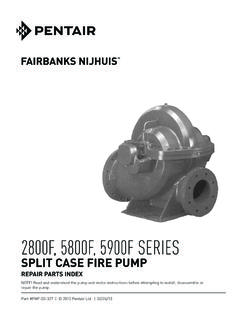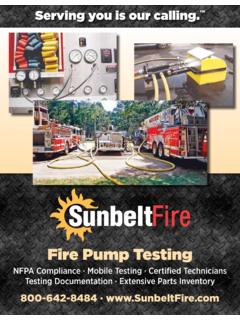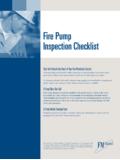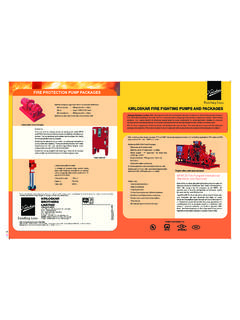Transcription of Graph Fire Pump Test - Inspector911
1 How to Graph fire Pump Test Results Example: (Also see the attached Graph paper for details.) fire Pump Rating From Pump Name Plate: Churn 60 psi, 1000 gpm @ 50 psi, 1500 gpm @ 32 psi, RPM 1750 Sprinkler Demand: 100 psi @ 600 gpm fire Pump Test Results: Note all Pitots are Hose Suction PSI Discharge PSI Pitot PSI GPM Total GPM RPM NET PSI Churn 50 113 0 0 0 1763 63 1 45 105 44 603 603 1760 60 2 30 84 30-30 498-498 996 1753 54
2 3 25 59 32-30-34 514,498,5301542 1750 34 Step 1: Place a dot on the Graph paper for each of the following points: 60 psi @ 0 gpm, 50 psi @ 1000 gpm, 32 psi @ 1500 gpm. Connect each dot with a line. The line represents the fire pump rating from the fire pump name plate and what it did at the factory. Step 2: Place a dot on the Graph paper for each of the following points that represented the NET pressure and flows during the test: Churn: 63 psi @ 0 gpm, Hose 1: 60 psi @ 603 gpm, Hose 2: 54 psi @ 996 gpm, Hose 3: 34psi @ 1542 psi.
3 Connect each dot with a line. The line represents the fire pump test results. Step 3: The line and points in step 2 should be within 95% of the line and points in step 1. If it is, the fire pump passes the test, if not, it fails. In this example the pump test is satisfactory. Step 4: Combined Curve: Place a dot on the Graph paper for each of the following points that represent the Discharge Pressure of the fire Pump Test: Churn: 113 psi @ 0 gpm, Hose 1: 105 psi @ 603 gpm, Hose 2: 84 psi @ 996 gpm, Hose 3: 59psi @ 1542 psi. Connect each dot with a line.
4 This represents the available water supply to the sprinkler system during a fire event. Place a dot at the Sprinkler Demand of: 100 psi @ 600 gpm. Step 5: Is the water supply adequate to meet the sprinkler demand? Yes. If the point was above the line in Step 4, the water supply would not be adequate to meet the sprinkler demand even with the fire pump operating. Further investigation would be needed including review of the sprinkler hydraulics by a fire protection engineer. Step 6: Electric Driver: Rating: Volts 460, Amps: Service Factor.
5 Volts Amps Hose Volts Volts Volts Amps Amps Amps Churn 460 460 460 34 34 33 Hose 1 460 460 460 37 36 36 Hose 2 460 460 460 44 43 43 Hose 3 460 460 460 52 51 52 As per NFPA 25 the maximum amps is the motor amps times the Service Factor listed on the motor.
6 Our example: amps x service factor = amps. Per NFPA 25 volts can be no more then 5% below or 10% above motor name plate rating. Our example that would be a low of 437 volts and a high of 506 volts. During the test the maximum Volts is 460 and the maximum amps is 53, the volt and amp readings are acceptable.






